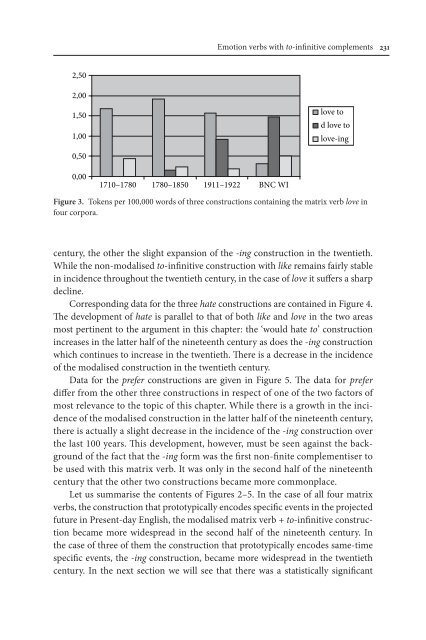Selected Papers from the Fourteenth International ... - STIBA Malang
Selected Papers from the Fourteenth International ... - STIBA Malang
Selected Papers from the Fourteenth International ... - STIBA Malang
Create successful ePaper yourself
Turn your PDF publications into a flip-book with our unique Google optimized e-Paper software.
2,50<br />
2,00<br />
1,50<br />
1,00<br />
0,50<br />
0,00<br />
1710–1780 1780–1850 1911–1922 BNC WI<br />
Emotion verbs with to-infinitive complements 2 1<br />
love to<br />
d love to<br />
love-ing<br />
Figure 3. Tokens per 00,000 words of three constructions containing <strong>the</strong> matrix verb love in<br />
four corpora.<br />
century, <strong>the</strong> o<strong>the</strong>r <strong>the</strong> slight expansion of <strong>the</strong> -ing construction in <strong>the</strong> twentieth.<br />
While <strong>the</strong> non-modalised to-infinitive construction with like remains fairly stable<br />
in incidence throughout <strong>the</strong> twentieth century, in <strong>the</strong> case of love it suffers a sharp<br />
decline.<br />
Corresponding data for <strong>the</strong> three hate constructions are contained in Figure 4.<br />
The development of hate is parallel to that of both like and love in <strong>the</strong> two areas<br />
most pertinent to <strong>the</strong> argument in this chapter: <strong>the</strong> ‘would hate to’ construction<br />
increases in <strong>the</strong> latter half of <strong>the</strong> nineteenth century as does <strong>the</strong> -ing construction<br />
which continues to increase in <strong>the</strong> twentieth. There is a decrease in <strong>the</strong> incidence<br />
of <strong>the</strong> modalised construction in <strong>the</strong> twentieth century.<br />
Data for <strong>the</strong> prefer constructions are given in Figure 5. The data for prefer<br />
differ <strong>from</strong> <strong>the</strong> o<strong>the</strong>r three constructions in respect of one of <strong>the</strong> two factors of<br />
most relevance to <strong>the</strong> topic of this chapter. While <strong>the</strong>re is a growth in <strong>the</strong> incidence<br />
of <strong>the</strong> modalised construction in <strong>the</strong> latter half of <strong>the</strong> nineteenth century,<br />
<strong>the</strong>re is actually a slight decrease in <strong>the</strong> incidence of <strong>the</strong> -ing construction over<br />
<strong>the</strong> last 00 years. This development, however, must be seen against <strong>the</strong> background<br />
of <strong>the</strong> fact that <strong>the</strong> -ing form was <strong>the</strong> first non-finite complementiser to<br />
be used with this matrix verb. It was only in <strong>the</strong> second half of <strong>the</strong> nineteenth<br />
century that <strong>the</strong> o<strong>the</strong>r two constructions became more commonplace.<br />
Let us summarise <strong>the</strong> contents of Figures 2–5. In <strong>the</strong> case of all four matrix<br />
verbs, <strong>the</strong> construction that prototypically encodes specific events in <strong>the</strong> projected<br />
future in Present-day English, <strong>the</strong> modalised matrix verb + to-infinitive construction<br />
became more widespread in <strong>the</strong> second half of <strong>the</strong> nineteenth century. In<br />
<strong>the</strong> case of three of <strong>the</strong>m <strong>the</strong> construction that prototypically encodes same-time<br />
specific events, <strong>the</strong> -ing construction, became more widespread in <strong>the</strong> twentieth<br />
century. In <strong>the</strong> next section we will see that <strong>the</strong>re was a statistically significant










